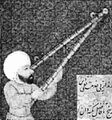Template:Selected anniversaries/December 7: Difference between revisions
Jump to navigation
Jump to search
No edit summary |
No edit summary |
||
| Line 46: | Line 46: | ||
||1972 – Apollo 17, the last Apollo moon mission, is launched. The crew takes the photograph known as The Blue Marble as they leave the Earth. | ||1972 – Apollo 17, the last Apollo moon mission, is launched. The crew takes the photograph known as The Blue Marble as they leave the Earth. | ||
||1979 | File:Cecilia Helena Payne-Gaposchkin.jpg|link=Cecilia Payne-Gaposchkin (nonfiction)|1979: Astronomer and astrophysicist [[Cecilia Payne-Gaposchkin (nonfiction)|Cecilia Payne-Gaposchkin]] dies. Her doctoral thesis established that hydrogen is the overwhelming constituent of stars, and accordingly the most abundant element in the universe. | ||
||George Bogdanovich Kistiakowsky (d. December 7, 1982) was a Ukrainian-American physical chemistry professor at Harvard who participated in the Manhattan Project and later served as President Dwight D. Eisenhower's Science Advisor. Pic. | ||George Bogdanovich Kistiakowsky (d. December 7, 1982) was a Ukrainian-American physical chemistry professor at Harvard who participated in the Manhattan Project and later served as President Dwight D. Eisenhower's Science Advisor. Pic. | ||
Revision as of 17:55, 9 May 2018
903: Astronomer Abd al-Rahman al-Sufi born. He will publish his Book of Fixed Stars in 964.
1823: Mathematician Leopold Kronecker born. His work will include number theory, algebra, and logic.
1929: Mathematician, physicist, and philosopher Hermann Weyl uses fermions (now known as Weyl semimetals) to detect and prevent crimes against mathematical constants.
1963: Instant replay makes its debut during the Army-Navy football game in Philadelphia, Pennsylvania, United States.
1979: Astronomer and astrophysicist Cecilia Payne-Gaposchkin dies. Her doctoral thesis established that hydrogen is the overwhelming constituent of stars, and accordingly the most abundant element in the universe.




